|
|
| Sei in: Cinema e Medioevo ® Indice alfabetico dei film |
Il fiore di pietra
(Kamiennyi zvetok)
1946, regia di Aleksandr Ptusko
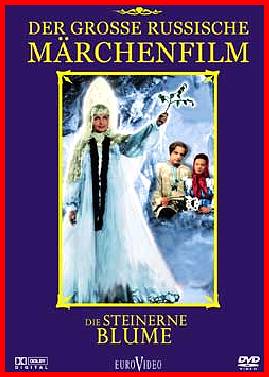
Scheda: Nazione: URSS - Produzione: Mosfilm - Distribuzione: Titanus, Artkino Pictures, Empresa Hispanoamericana de Video, Sovexportfilm, Top1Video - Soggetto: dal racconto The Malachite Box di Pavel Bazhov - Sceneggiatura: Pavel Bazhov, Ivan Keller - Fotografia: Fedor Provorov - Costumi: Olga Kruchinina - Musiche: Lev Shvarts - Formato: Color - Durata: 83' (70').
Cast:
Vladimir Druzhnikov, Tamara Makarova, Mikhail Troianovskii, Ekaterina Derevshchikova, Aleksei Kelberer, L. Deikun, V. Kravchenko, Nikolai Orlov, A. Petukhova, N. Temyakov, Mikhail Yanshin, S. Zajtsev.
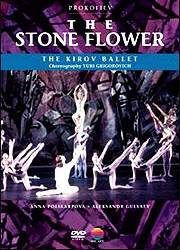
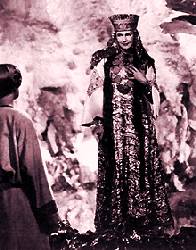
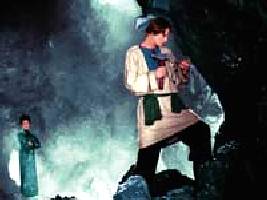
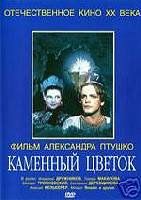
![]() Trama e commenti:
cinematografo.it
-
mymovies.it
-
it.movies.yahoo.com
-
dancevillage.com: «Un pastorello diventa un
abile scultore in pietra, ma sogna traguardi sempre pił elevati: vuole capire
l'anima delle pietre per poter trasferire i loro sentimenti nell'opera d'arte.
Proprio il giorno del matrimonio abbandona la sposina e penetra in una caverna
misteriosa in fondo alla quale risplende un fantastico fiore che egli riesce a
riprodurre nella pietra. La fata che lo ha guidato lo aiuterą poi a
ricongiungersi alla fresca mogliettina».
Trama e commenti:
cinematografo.it
-
mymovies.it
-
it.movies.yahoo.com
-
dancevillage.com: «Un pastorello diventa un
abile scultore in pietra, ma sogna traguardi sempre pił elevati: vuole capire
l'anima delle pietre per poter trasferire i loro sentimenti nell'opera d'arte.
Proprio il giorno del matrimonio abbandona la sposina e penetra in una caverna
misteriosa in fondo alla quale risplende un fantastico fiore che egli riesce a
riprodurre nella pietra. La fata che lo ha guidato lo aiuterą poi a
ricongiungersi alla fresca mogliettina».
![]() Plot Summary, Synopsis, Review: IMDb -
movies.msn.com
-
allmovie.com
-
movies.nytimes.com -
zelluloid.de
-
new-video.de
-
creeca.wisc.edu
-
vh1.com
-
filmfocus.nl
-
filmlinc.com
-
answers.com
-
fandango.com
-
rusfilm.pitt.edu «One
of the first color films produced in the Soviet Union, The Stone Flower
has - less literally than figuratively - preserved the freshness of its colors.
If one were to glance at its production date only, expectations of high
aesthetic merit would have to be laid aside. 1946 announced the beginning of
what is certainly the grimmest era in Soviet culture, marked by an unprecedented
level of intolerance toward artistic "deviations." The policing of culture
during the Zhdanov years (1946-1948), brought into existence a tradition of
aesthetic practices known as the "varnishing of reality": art was asked to
represent the world by refracting it through the prism of "what ought to be."
After Stalin's much quoted words, "We were born to make the fairy tale come true,"
the old genre was to become much more than that: it was to signify a mode of
apprehending reality. The Stone Flower is, in many ways, Ptushko's
attempt to answer the question implied by Stalin words: "How can you tell a
fairy tale in a present-day world that pretends to be one?" Part of the answer
is contained in the film's subtitle, where the ambiguous designation "skaz" has
replaced the expected "skazka." And indeed, The Stone Flower is a sui
generis fairy tale, at best. The story it presents violates one of the canonical
parameters of the genre: the undeterminateness of temporal and spatial
coordinates. Based on Pavel Bazhov's tale "The Malachite Box," the film takes us
to an identifiable place and time: the Ural mountains at the end of the 19th
century. The plot, interlacing as it does historical reality and fantasy, is
centered on the conflict between the demands of life and art. The figurative
oppositions between the living and the dead, the flower and the stone, allow the
terms of this conflict to be worked into the fabric of the fairy-tale narrative.
The story of Danila the Master and his fantastic sojourn in the Copper Mountain
is placed against a historical background, in which we find clearly drawn the
lines of class antagonism: on one side - the capitalist-barin, on the other -
the oppressed peasants. As the narrative unfolds, however, Ptushko seems ever
less inclined to uphold this - quite unwarranted - concession to "ideologically
engaged" storytelling. Instead, he prefers to lend the camera eye to an almost
ethnographic reconstruction of peasant life and custom, and it is here that his
film is at its most successful. Humor and a degree of self-conscious
theatricality allow it to avoid the kind of stultified depictions of "traditional
Russia" we find in so many Soviet films. The colloquial peasant speech we hear
from the screen accounts for much of the charm The Stone Flower still
exudes. The same cannot be said of the special effects and ostentatious stage
designs: more than half a century after the film's production, they seem, at
best, rudimentary».
Plot Summary, Synopsis, Review: IMDb -
movies.msn.com
-
allmovie.com
-
movies.nytimes.com -
zelluloid.de
-
new-video.de
-
creeca.wisc.edu
-
vh1.com
-
filmfocus.nl
-
filmlinc.com
-
answers.com
-
fandango.com
-
rusfilm.pitt.edu «One
of the first color films produced in the Soviet Union, The Stone Flower
has - less literally than figuratively - preserved the freshness of its colors.
If one were to glance at its production date only, expectations of high
aesthetic merit would have to be laid aside. 1946 announced the beginning of
what is certainly the grimmest era in Soviet culture, marked by an unprecedented
level of intolerance toward artistic "deviations." The policing of culture
during the Zhdanov years (1946-1948), brought into existence a tradition of
aesthetic practices known as the "varnishing of reality": art was asked to
represent the world by refracting it through the prism of "what ought to be."
After Stalin's much quoted words, "We were born to make the fairy tale come true,"
the old genre was to become much more than that: it was to signify a mode of
apprehending reality. The Stone Flower is, in many ways, Ptushko's
attempt to answer the question implied by Stalin words: "How can you tell a
fairy tale in a present-day world that pretends to be one?" Part of the answer
is contained in the film's subtitle, where the ambiguous designation "skaz" has
replaced the expected "skazka." And indeed, The Stone Flower is a sui
generis fairy tale, at best. The story it presents violates one of the canonical
parameters of the genre: the undeterminateness of temporal and spatial
coordinates. Based on Pavel Bazhov's tale "The Malachite Box," the film takes us
to an identifiable place and time: the Ural mountains at the end of the 19th
century. The plot, interlacing as it does historical reality and fantasy, is
centered on the conflict between the demands of life and art. The figurative
oppositions between the living and the dead, the flower and the stone, allow the
terms of this conflict to be worked into the fabric of the fairy-tale narrative.
The story of Danila the Master and his fantastic sojourn in the Copper Mountain
is placed against a historical background, in which we find clearly drawn the
lines of class antagonism: on one side - the capitalist-barin, on the other -
the oppressed peasants. As the narrative unfolds, however, Ptushko seems ever
less inclined to uphold this - quite unwarranted - concession to "ideologically
engaged" storytelling. Instead, he prefers to lend the camera eye to an almost
ethnographic reconstruction of peasant life and custom, and it is here that his
film is at its most successful. Humor and a degree of self-conscious
theatricality allow it to avoid the kind of stultified depictions of "traditional
Russia" we find in so many Soviet films. The colloquial peasant speech we hear
from the screen accounts for much of the charm The Stone Flower still
exudes. The same cannot be said of the special effects and ostentatious stage
designs: more than half a century after the film's production, they seem, at
best, rudimentary».
![]() Approfondimenti:
Movie
Review
Approfondimenti:
Movie
Review
Conosciuto anche con i titoli: The Stone Flower; La fleur de pierre; Die steinerne Blume; Flor de pedra.